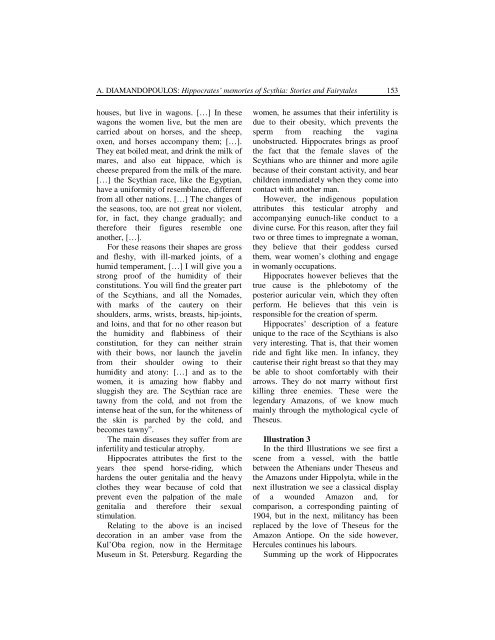Series VI: Medical Sciences – SUPPLEMENT ... - Krongres
Series VI: Medical Sciences – SUPPLEMENT ... - Krongres
Series VI: Medical Sciences – SUPPLEMENT ... - Krongres
Create successful ePaper yourself
Turn your PDF publications into a flip-book with our unique Google optimized e-Paper software.
�. DIAMANDOPOULOS: Hippocrates’ memories of Scythia: Stories and Fairytales 153<br />
houses, but live in wagons. […] In these<br />
wagons the women live, but the men are<br />
carried about on horses, and the sheep,<br />
oxen, and horses accompany them; […].<br />
They eat boiled meat, and drink the milk of<br />
mares, and also eat hippace, which is<br />
cheese prepared from the milk of the mare.<br />
[…] the Scythian race, like the Egyptian,<br />
have a uniformity of resemblance, different<br />
from all other nations. […] The changes of<br />
the seasons, too, are not great nor violent,<br />
for, in fact, they change gradually; and<br />
therefore their figures resemble one<br />
another, […].<br />
For these reasons their shapes are gross<br />
and fleshy, with ill-marked joints, of a<br />
humid temperament, […] I will give you a<br />
strong proof of the humidity of their<br />
constitutions. You will find the greater part<br />
of the Scythians, and all the Nomades,<br />
with marks of the cautery on their<br />
shoulders, arms, wrists, breasts, hip-joints,<br />
and loins, and that for no other reason but<br />
the humidity and flabbiness of their<br />
constitution, for they can neither strain<br />
with their bows, nor launch the javelin<br />
from their shoulder owing to their<br />
humidity and atony: […] and as to the<br />
women, it is amazing how flabby and<br />
sluggish they are. The Scythian race are<br />
tawny from the cold, and not from the<br />
intense heat of the sun, for the whiteness of<br />
the skin is parched by the cold, and<br />
becomes tawny”.<br />
The main diseases they suffer from are<br />
infertility and testicular atrophy.<br />
Hippocrates attributes the first to the<br />
years thee spend horse-riding, which<br />
hardens the outer genitalia and the heavy<br />
clothes they wear because of cold that<br />
prevent even the palpation of the male<br />
genitalia and therefore their sexual<br />
stimulation.<br />
Relating to the above is an incised<br />
decoration in an amber vase from the<br />
Kul’Oba region, now in the Hermitage<br />
Museum in St. Petersburg. Regarding the<br />
women, he assumes that their infertility is<br />
due to their obesity, which prevents the<br />
sperm from reaching the vagina<br />
unobstructed. Hippocrates brings as proof<br />
the fact that the female slaves of the<br />
Scythians who are thinner and more agile<br />
because of their constant activity, and bear<br />
children immediately when they come into<br />
contact with another man.<br />
However, the indigenous population<br />
attributes this testicular atrophy and<br />
accompanying eunuch-like conduct to a<br />
divine curse. For this reason, after they fail<br />
two or three times to impregnate a woman,<br />
they believe that their goddess cursed<br />
them, wear women’s clothing and engage<br />
in womanly occupations.<br />
Hippocrates however believes that the<br />
true cause is the phlebotomy of the<br />
posterior auricular vein, which they often<br />
perform. He believes that this vein is<br />
responsible for the creation of sperm.<br />
Hippocrates’ description of a feature<br />
unique to the race of the Scythians is also<br />
very interesting. That is, that their women<br />
ride and fight like men. In infancy, they<br />
cauterise their right breast so that they may<br />
be able to shoot comfortably with their<br />
arrows. They do not marry without first<br />
killing three enemies. These were the<br />
legendary Amazons, of we know much<br />
mainly through the mythological cycle of<br />
Theseus.<br />
Illustration 3<br />
In the third Illustrations we see first a<br />
scene from a vessel, with the battle<br />
between the Athenians under Theseus and<br />
the Amazons under Hippolyta, while in the<br />
next illustration we see a classical display<br />
of a wounded Amazon and, for<br />
comparison, a corresponding painting of<br />
1904, but in the next, militancy has been<br />
replaced by the love of Theseus for the<br />
Amazon Antiope. On the side however,<br />
Hercules continues his labours.<br />
Summing up the work of Hippocrates


